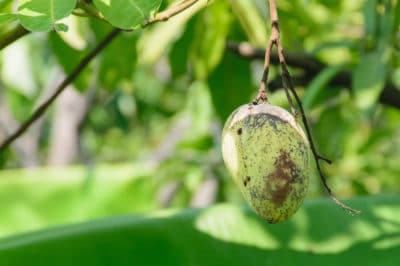Start the Mango Tree off Right
Whether grown in a container or directly in the landscape, give your mango tree the best start by making sure it’s planted and grown in a preferred location:
- Grow in a sunny location.
- Plant in well-drained, native soil or potting mix.
- If grown in a container, make sure there’s bottom drainage and it’s at least 5 to 7 gallons (18.9 to 26.5 liters) in size.
Expert Tip: Mangos grow well in USDA zones 9b through 11 where freezes rarely occur.
Irrigation Needs
Water newly planted mango trees immediately after planting and every other day for several weeks. Depending on local weather conditions, for the next few months, water the tree several times weekly. For the following three years while the tree matures, weekly water applications are sufficient, with monthly applications during winter. Thereafter, and unless conditions are hot and dry, watering through rain is usually sufficient for proper growth.
Fertilization Needs
It’s best to feed mango trees with organic blends, since the tree is highly sensitive and prone to fertilizer burn. Apply three times yearly – spring, summer and fall – by spreading an equal amount out to and around the dripline of the tree and watering well.
Before the tree begins flowering and fruiting, its nitrogen requirements are higher than when it starts producing. Once the tree flowers, it requires more potassium and phosphorus, which promotes flowering and fruiting. Some organic products good for feeding mangos include:
- Nitrogen: Compost for low amounts, well-aged manure
- Potassium: Compost, potassium sulfate, seaweed
- Phosphorus: Compost, blood meal, bone meal, guano, rock phosphate
Pest-Control
Although they rarely affect fruit-production and warrant control, pests like thrips, mites and scale occasionally infest mango trees. If the infestation becomes large and you can easily reach all areas of the tree, you can spray the insects with a horticultural oil or insecticidal soap.
To prevent burning the foliage, apply the oil when conditions aren’t sunny, like late afternoon or early evening, applying to both sides of the leaves and affected portions of the tree. Repeat weekly.
Common Diseases
Meeting the mango tree’s preferred cultural requirements like proper sun, soil and air circulation, goes a long way in preventing disease problems. Keeping the foliage, flowers and fruits dry by irrigating around the base of the tree, also helps prevent problems, as does keeping the area beneath the tree cleaned of fallen debris and fruit.
It’s also easier to control potential problems before they rear their ugly heads with several preventative fungicides sprays before bud break and newly developing foliage appears. Listed below are some of the most common issues with mango trees and their control.
Powdery Mildew (Oidium sp.)
The fungus covers all portions of the tree in a white powder and if left untreated, severely affects flowering and fruit-production. Symptoms are most common in spring. Spraying the tree right before bud break with powdered kelp or sodium bicarbonate, and retreating about 20 days later, usually controls the problem.
Anthracnose (Colletotrichum gloeosporiodes)
Anthracnose is one of the most common and important diseases of mango trees. The fungus attacks and affects twigs, flowers, foliage and fruits, as well as fruit held in storage. Symptoms include black, irregularly shaped, sunken lesions that grow larger as the disease develops, damaging blossoms, spotting of foliage, fruit staining and rot.
Environmental conditions such as rain, heavy fog and dew make the mango tree more susceptible to infection. Prevention is as easy as thoroughly spraying the tree as the flowers begin to open and after harvest with a copper fungicide.
Mango Scab (Elsinoe mangiferae)
In the early stages of infection, the mango scab fungus can resemble an outbreak of anthracnose. It affects the same portions of the tree, but as the infection grows, corky lesions develop on the foliage and fruits and leaf distortion occurs. It’s generally not a problem because spraying the tree with fungicides to control anthracnose controls the outbreak.
Pruning
Mango trees require very little pruning, unless you desire to control the tree’s mature size to make it easier to harvest fruit or it’s growing inside a container. While the tree is young, pruning to increase lateral branches and removing several of the upper branches back to their crotch creates a strong structure and more fruit-producing branches. Other than removing diseased, dead or broken branches, pruning should be done after the fruit is harvested.
Severe pruning does not damage established mango trees, but the amount of mangos produced are affected for several seasons after. Since mature mango trees grow quite large, you might want to call in a professional tree trimmer to do any pruning.
Expert Tips: If you are susceptible to allergic outbreaks to poison ivy and poison oak, you should wear a long sleeved shirt and gloves when pruning mango trees or handling the fruit, as the sap and debris causes allergic dermatitis in some people.
